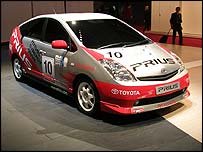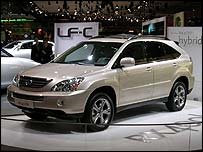Peter Valdes-Dapena, CNN/Money staff writer
NEW YORK (CNN/Money) - High-rolling exotic car aficionados are familiar the idea of months-long waiting lists for new models. Now gas-sippers are joining the rubber-scorchers as waiting lists for the
Are they worth the wait?
In a purely economic sense, it's difficult to make the case for h
There are a lot of other factors to consider. People make far sillier car purchases for reasons of public image and trendiness all the time.
To decide how much sense it makes, start by asking yourself these questions.
Drive much?
The less you drive, the longer it's going to take to make up the added cost of a hybrid as compared to a similar non-hybrid car.
Official government estimates give the Prius 60 miles to the gallon in city driving and 51 on the highway. (Please don't write in to tell us those numbers are backward. Hybrids get better mileage in the city than on the highway.) Those figures are EPA estimates, though. Your mileage may vary, as they say.
But you pay a lot for that fuel efficiency. To see how much more, consider the hybrid version of the Honda Civic and upcoming Ford Escape SUV, which both cost about $3,200 more than their respective non-hybrid versions.
To make up the difference in price, Kelley Blue Book estimated that the average Civic Hybrid driver would have to travel at least 180,000 miles, assuming $2.15 a gallon of gas. (If gas prices stay lower than that, you'd have to drive even more to make up the difference.)
What's the premium for a Prius? There is no non-hybrid Prius with which to make a comparison. But in terms of size and interior space, the most similar car in the Toyota line-up is the Camry (though Prius shoppers are more likely to also research the Corolla, according to data from Edmunds.com.)
The Prius costs about $2,200 more than a base four-cylinder Camry with an automatic transmission. The difference in fuel efficiency between the Camry and Prius is greater than that between the Honda Civics. It would take 60,000 miles of driving, an amount the average driver covers in about 4 years, to cover the additional cost of the Prius over a Camry LE, according to calculations provided by Kelley Blue Book.
Have a really lousy commute?
If you spend lots of time plying America's broad ribbons of interstate, you'll get a lot less savings from a hybrid than you might think. Unlike non-
Since electric motors are better than gasoline engines at supplying low-speed acceleration, the electric motor is does a large part of the work when starting from a dead stop. When the car is up to cruising speed, the gasoline engine takes over completely. Whenever a hybrid car is stopped, in fact, the gasoline is often turned off altogether.
Getting the possible best mileage from a Prius requires some counter-intuitive use of the gas pedal, said James Bell, a Prius owner and director of sales for automotive data company IntelliChoice. Slowing down and speeding up a lot actually improves his highway mileage, he said.
The
It's smoggy out. Do you care?
If you're just interested in saving money on gas, a diesel might make more sense. A turbo-diesel Volkswagen, for example, gets much better gas mileage than a car with a gasoline engine without resorting to complex, expensive electrical technology.
Hybrids already coming:
Vehicle Available
Ford Escape hybrid Fall, 2004
Lexus RX400 h Fall, 2004
GMC Sierra 1500 hybrid Fall, 2004 (fleet only)
Dodge Ram hybrid Fall, 2004 (fleet only)
Honda Accord hybrid Fall, 2004
Toyota Highlander hybrid Early 2005
Saturn VUE hybrid Not announced
The Volkswagen Jetta TDI gets an EPA estimated 41 mpg overall compared to an overall 24 mpg for the a Jetta with the 1.8 liter regular gasoline engine. While not as good as a hybrid car, the Jetta TDI's fuel mileage is still outstanding.
 The Jetta TDI will also contribute less to possible global warming problems than the standard car. The diesel produces 5.1 tons of greenhouse gases a year, according to EPA estimates. That might sound like a lot, but the standard-engined Jetta produces 2.8 tons more each year.
The Jetta TDI will also contribute less to possible global warming problems than the standard car. The diesel produces 5.1 tons of greenhouse gases a year, according to EPA estimates. That might sound like a lot, but the standard-engined Jetta produces 2.8 tons more each year.(Picture Left: A "Hybrid" badge is one of the few, subtle marks that a Honda Civic Hybrid is different.)
The hybrid Prius produces even less, though, at just 3.5 tons. And when it comes to air pollution in general, the Prius rates a nine or 10 out on the EPA's 10-point scale depending on the state where it's purchased. The Jetta TDI earns a rating of just four.
So if you're concerned about the impact your driving has on the environment, diesels still aren't as clean as hybrids in spite of recent advances in diesel technology. If you just want to save gas, a diesel will get you much better mileage than a standard gasoline engine without all the added cost and complexity of a hybrid.
Do you care who knows?
There are more hybrid options out there than just the Prius and more are on the way. But it's the Prius that leaps to mind when the word "hybrid" is mentioned.
To some degree, that arises from the fact that the Prius is available only as a hybrid and, frankly, it looks like a hybrid car. Its most similar competitor, the Civic Hybrid, looks little different from a regular, "all combustion, all the time" Honda Civic.
That may limit the appeal of the Civic. Other than an upturned lip on the trunk to improve aerodynamics and a special badge, there's little on a Civic Hybrid to let the world know that you're driving a hybrid. If you're trying to send a message, the Civic Hybrid sends it only as far as the car that's tailgating you.
The Prius distinctive appearance was important to Bell of IntelliChoice, for instance. He felt it was important that people see him as knowledgeable about the latest automotive technology and the Prius was sort of a rolling billboard for that.
"There's a ton of Civics driving around," he said. Read More..













